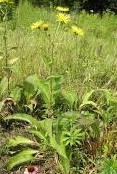Area
Grows in wet lands * on streams, in Utloks and among bushes. Occurs in the deserts and forest-desert zones of the Caucasus, Central Asia, Moldova, Ukraine, Belarus, the European part of Russia, and in Western Siberia. The product is mainly produced in Krasnodar and Tavropol Territories, as well as in Kazakhstan and elsewhere.
Botanical description of the plant
A perennial herb, 100-150 cm tall. Stems one or more, erect, hardy, branched at the top. The rhizome is elongated, large (the leaf blade is up to 50 cm), elliptical or oblong-ovate, with a sharp tip, narrowing towards the base. The leaves on the stem are small, elongated ovate, and shrink as they rise to the top of the stem. The leaf blade is serrated angular, the upper side sparse and hard hairy, the lower side soft, hard. The leaves at the top of the stem are unbroken, while those at the bottom are short at the base arranged in series. The flowers are golden in color and are collected in a basket. Baskets form a shield or cluster of flowers at the top of the stems and branches. The wrapping leaves of the basket are arranged like tiles. The leaves are ovoid, curved and covered with many feathers. The flowers on the edge of the basket are yellow, talismanic, and in the middle are also yellow, hairy, tube-shaped. The calyx petals of the flowers are hairy, the petals and paternal are 5, the maternal node is one-lobed, located below. Fruit - elongated, quadrangular, brown or brown list. It blooms from July to September, the fruits ripen in August-October.

Medicinal properties
The drug andiz is used as a expectorant, as well as in diseases of the stomach and intestines. The essential oil has antiseptic, worm-driving properties and anti-inflammatory effect. Its worm-repellent properties include substances similar to santon - due to the presence of alantolactones The drug allanton is derived from the rhizome and root of black andis. Allanton is a combination of sesquiterpenes of the product, which has anti-inflammatory, strengthening and antiseptic effect, and accelerates wound healing in peptic ulcer disease. This drug is consumed in the form of one tablet 3-4 times a day and flour for the treatment of two fingers, intestinal ulcers. Dorivor preparations. Decoction, allanton (in tablet form).
Growing technology
Tall andiz can be planted and propagated in all soil types of Uzbekistan. But if the meadow, sandy or slightly healthy soil loam, light upon light.
The roots are very deep, so plowing before planting should be carried out at a depth of 30 cm. Before plowing, 200 kg of superphosphate is applied per hectare. Nitrogen fertilizers are applied in the first year, during the period of 2–3-leaf emergence, as well as during the formation of regenerating buds (July) at 100 kg per hectare. Propagated by seeds. Seeds are sown dry in spring or autumn at the rate of 10-12 kg per hectare, row spacing at 70 cm. Seeds are sown to a depth of 0.5–1 cm. In 7-10 days the seeds germinate and the grass is formed, in the period of 2-3 leaves germination, in the annual crop area, each bush spacing is 10-15 cm, at the same time this process is carried out by weeding. Given that the central root network of tall andiz is strong and well developed, it is watered every 20-25 days at the following times: May-1, June-2, July-2, August-1/2, September-1, a total of 7-8 in the first year times, watered 6–7 times in the second year. In the first year the plant forms a cone of 70 leaves up to 70 cm long. Tuganak - the cross section of the root tip reaches 5 cm during the season. It is a thick cylindrical, 7 cm long structure, often with second-order thick roots extending from its base. The average weight of such an annual undried root reaches 73.6 g, and some up to 200 g. A two- and three-year-old plant is acceptable for obtaining seeds and roots. The amount of fertilizer to be applied per hectare: phosphorus fertilizers 200, and nitrogen fertilizers once in June, 100-200 kg.





